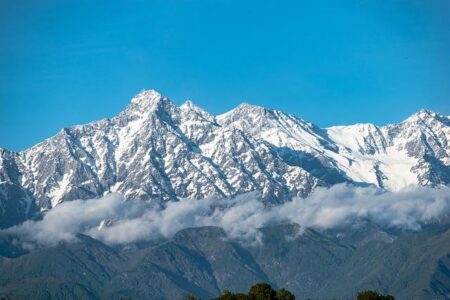After decades of planning and construction, the long-awaited rail line to Kashmir is finally nearing completion, promising to transform connectivity in one of India’s most remote and strategically significant regions. Heralded as an engineering marvel, this ambitious infrastructure project has overcome some of the most challenging terrains and climatic conditions in the world. As the railway inches closer to operational status, it stands poised to usher in new economic opportunities, boost tourism, and enhance national integration, marking a historic milestone in South Asia’s transportation landscape.
Engineering Challenges Overcome in Constructing the Kashmir Rail Link
The construction of the Kashmir rail link confronted unprecedented engineering obstacles, stemming largely from the region’s volatile geography and climate. Engineers had to navigate through treacherous mountainous terrain riddled with unstable rock formations, frequent landslides, and seismic activity. The project demanded the creation of several world-class tunnels and bridges – each pushing the boundaries of conventional engineering. Among these feats, the iconic Chenab Bridge, the world’s highest rail bridge, stands out as a testament to cutting-edge design, with its robust steel arch soaring over 1,300 feet above the turbulent river below.
Innovative solutions were imperative to counteract the region’s extreme weather, which oscillates between heavy snowfall and monsoon rains, often halting construction efforts. Key challenges included:
- Ensuring structural integrity in seismically active zones with specially engineered shock-absorbing foundations.
- Precision tunneling using tunnel boring machines adapted for hard rock and fractured strata.
- Mitigating environmental impact by employing state-of-the-art erosion control and slope stabilization techniques.
- Addressing logistical constraints caused by limited accessibility and harsh weather conditions, requiring adaptive construction scheduling.
| Engineering Aspect | Challenge | Solution | ||||||||||||||||||||||||||
|---|---|---|---|---|---|---|---|---|---|---|---|---|---|---|---|---|---|---|---|---|---|---|---|---|---|---|---|---|
| Tunnel Construction | Unstable rock & seismic shifts | Custom TBMs with seismic sensors | ||||||||||||||||||||||||||
| Bridge Engineering | High winds & deep valleys |
| Economic Indicator | Pre-Rail Line | Post-Rail Line (2 Years) |
|---|---|---|
| Tourism Revenue (in crore ₹) | 150 | 380 |
| Local Employment (in thousands) | 45 | 78 |
| Freight Volume (in tons) | 120,000 | 230,000 |
Socially, the rail connectivity has fostered stronger integration within the region and with the rest of the country. The enhanced mobility has made it easier for students to access education hubs and healthcare services, contributing to improved quality of life. Communities once divided by rugged mountains now engage in richer cultural exchanges, promoting social cohesion and a unified identity. However, this rapid development calls for sustainable management to ensure that environmental concerns and traditional lifestyles are respected amid modernization efforts.
- Education Access: Increased student enrollments in regional universities.
- Healthcare Reach: Faster emergency and routine medical transport.
- Cultural Exchange: Revival of festivals and inter-community events.
Recommendations for Sustained Maintenance and Future Expansion Plans
To ensure the longevity and reliability of this monumental rail link to Kashmir, a robust maintenance strategy must be embedded within every operational phase. Prioritizing regular inspections of critical infrastructure such as tunnels, bridges, and track systems will avert potential disruptions brought on by the region’s challenging terrain and weather conditions. Employing advanced monitoring technologies-including drone surveillance and sensor networks-can provide real-time data to maintenance crews, enabling proactive responses to any wear or damage. Additionally, fostering a skilled local workforce for ongoing upkeep will not only support sustained operations but also create valuable regional employment opportunities.
Looking ahead, the project’s scalability hinges on both technological innovation and strategic planning. Plans for future expansion include extending service lines to remote mountainous villages, thereby integrating isolated communities more fully into the economic fold. To guide this expansion, the following priorities have been outlined:
- Invest in eco-friendly propulsion systems to reduce environmental impact amid sensitive Himalayan ecosystems.
- Enhance passenger amenities, ensuring comfort and safety on longer routes.
- Upgrade signaling and communication networks for faster and safer rail traffic management.
- Develop multimodal transport hubs connecting rail with road and air transit options.
| Aspect | Short-Term Focus | Long-Term Goal |
|---|---|---|
| Infrastructure | Routine structural audits | Extension to remote settlements |
| Technology | Implement sensor arrays | AI-driven predictive maintenance |
| Community | Train local maintenance teams | Boost regional economic integration |
| Sustainability | Regular environmental impact assessments | Carbon-neutral operations |
In Conclusion
As the ambitious rail line to Kashmir nears completion, it stands as a testament to decades of engineering innovation, resilience, and strategic vision. Beyond its steel tracks and tunnels, the project symbolizes a new chapter of connectivity and economic opportunity for the region. While challenges remain, this monumental undertaking underscores the transformative power of infrastructure in shaping both landscapes and livelihoods, promising to redefine travel and trade in one of the world’s most challenging terrains.




